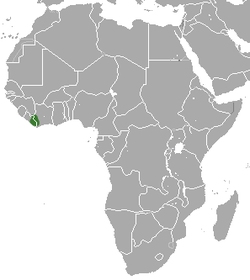Liberian mongoose
This article needs additional citations for verification. (October 2008) |
| Liberian mongoose[1] | |
|---|---|
| Conservation status | |
| Scientific classification | |
| Kingdom: | Animalia |
| Phylum: | Chordata |
| Class: | Mammalia |
| Order: | Carnivora |
| Family: | Herpestidae |
| Subfamily: | Herpestinae |
| Genus: | ''Liberiictis'' Hayman, 1958 |
| Species: | ''L. kuhni'' |
| Binomial name | |
| Liberiictis kuhni Hayman, 1958
| |

| |
| Range of the Liberian mongoose | |
The Liberian mongoose (Liberiictis kuhni) is a small carnivoran belonging to the mongoose family (Herpestidae). It is the only member of the genus Liberiictis.[3]
It was discovered in Liberia in 1958. Little was known about the animal, except what local natives related. They were said to live in small groups and fed on earthworms and various other insects. The exact distribution is unknown, but may extend from Sierra Leone to Côte d'Ivoire. Confirmed sightings are restricted to forests in Liberia and the Tai National Park in Côte d'Ivoire. A live specimen was exhibited at the Toronto Zoo, but civil war in Liberia has prevented further study. Due to its limited range and the fact that it is heavily hunted, the Liberian mongoose is considered endangered.
The Liberian mongoose has a primarily dark brown body, with a darker stripe on the neck and shoulders. This stripe is bordered by smaller stripes that are white. Compared with other mongoose species, the Liberian mongoose has rather long claws and an elongated snout with small teeth. One of the few specimens ever seen alive was found in a burrow close to a termite nest. The animal's physical characteristics, and its preferred locality to insects, has led experts to suggest that the Liberian mongoose is primarily insectivorous. The few observers that have witnessed this species in the wild have reported that the animal lives primarily in the trunks of trees. Indeed, some of the better-known mongoose species live in tree during the rainy season and occupy burrows only during hotter weather.
This species is extremely rare, and has been listed by the IUCN as endangered. Human destruction of their habitat and human hunting are the primary threats to Liberian mongooses. Owing to their rarity, they were not described until 1958,[4] with the first complete specimens discovered as recently as 1974. An attempt to study them in 1988 yielded only one animal, which had already been killed by a hunter. The specimen that lived at the Toronto Zoo has since died. Political unrest in the areas in which they live has made further studies difficult in recent years.
(Nowak, 1999; Taylor, 1992)
References
[edit]- ^ Template:MSW3
- ^ Template:IUCN2008 Database entry includes a brief justification of why this species is of vulnerable.
- ^ Template:MSW3
- ^ Hayman, Robert W. (1958). "A new genus and species of West African mongoose". Annals and Magazine of Natural History. 13 (1): 448–452.
- Pages using the JsonConfig extension
- Articles needing additional references from October 2008
- Articles with invalid date parameter in template
- All articles needing additional references
- IUCN Red List vulnerable species
- Articles with 'species' microformats
- Taxoboxes with the error color
- Taxobox articles possibly missing a taxonbar
- Mongooses
- Mammals of Africa
- Mammals of Liberia

